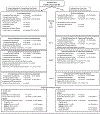An RCT of Dating Matters: Effects on Teen Dating Violence and Relationship Behaviors
- PMID: 31128957
- PMCID: PMC6953384
- DOI: 10.1016/j.amepre.2019.02.022
An RCT of Dating Matters: Effects on Teen Dating Violence and Relationship Behaviors
Abstract
Introduction: Teen dating violence is a serious public health problem with few effective prevention strategies. This study examines whether the Dating Matters comprehensive prevention model, compared with a standard of care intervention, prevented negative relationship behaviors and promoted positive relationship behaviors.
Study design: This longitudinal, cluster-RCT compared the effectiveness of Dating Matters with standard of care across middle school. Standard of care was an evidence-based teen dating violence prevention curriculum (Safe Dates) implemented in eighth grade.
Setting/participants: Forty-six middle schools in high-risk urban neighborhoods in four U.S. cities were randomized. Schools lost to follow-up were replaced with new schools, which were independently randomized (71% school retention). Students were surveyed in fall and spring of sixth, seventh, and eighth grades (2012-2016). The analysis sample includes students from schools implementing Dating Matters or standard of care for >2 years who started sixth grade in the fall of 2012 or 2013 and had dated (N=2,349 students, mean age 12 years, 49% female, and 55% black, non-Hispanic, 28% Hispanic, 17% other).
Intervention: Dating Matters is a comprehensive, multicomponent prevention model including classroom-delivered programs for sixth to eighth graders, training for parents of sixth to eighth graders, educator training, a youth communications program, and local health department activities to assess capacity and track teen dating violence-related policy and data.
Main outcome measures: Self-reported teen dating violence perpetration and victimization, use of negative conflict resolution strategies, and positive relationship skills were examined as outcomes. Imputation and analyses were conducted in 2017.
Results: Latent panel models demonstrated significant program effects for three of four outcomes; Dating Matters students reported 8.43% lower teen dating violence perpetration, 9.78% lower teen dating violence victimization, and 5.52% lower use of negative conflict resolution strategies, on average across time points and cohorts, than standard of care students. There were no significant effects on positive relationship behaviors.
Conclusions: Dating Matters demonstrates comparative effectiveness, through middle school, for reducing unhealthy relationship behaviors, such as teen dating violence and use of negative conflict resolution strategies, relative to the standard of care intervention.
Trial registration: This study is registered at www.clinicaltrials.gov NCT01672541.
Published by Elsevier Inc.
Figures




References
-
- CDC. Preventing Teen Dating Violence https://www.cdc.gov/violence-prevention/pdf/tdv-factsheet.pdf. Accessed May 13, 2019.
-
- Offenhauer P, Buchalter A. Teen Dating Violence: A Literature Review and Annotated Bibliography Washington, DC: Library of Congress, 2011.
Publication types
MeSH terms
Associated data
Grants and funding
LinkOut - more resources
Full Text Sources
Medical

